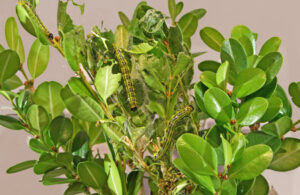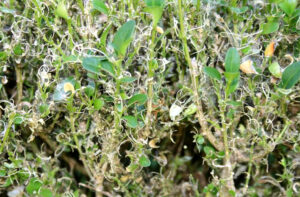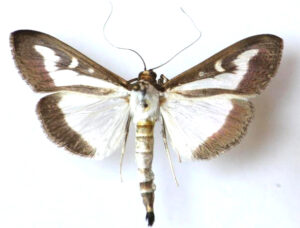Keep An Eye on Those Boxwoods
October 22nd, 2024
If you’re growing any boxwoods in your yard, you might want to make a note to check them starting next spring for the latest deadly threat facing our top-selling shrub.

Here’s a box tree moth caterpillar in action on a boxwood.
Credit: Hannah Nadel, USDA
A new bug called the box tree moth officially entered Pennsylvania this fall.
The state Agriculture Department confirmed reports of the bug’s find in two cemeteries in Erie County and promptly put a quarantine on boxwood sales in an effort to contain the bug to that county.
The caterpillars of this east-Asian species are potential boxwood killers, as most of Europe has been finding out since their arrival there in 2006. They can chew leaves to the point where there’s little left but bare twigs – “see-through boxwoods” as Ohio State Extension entomologist Joe Boggs calls the remnants.
According to the U.S. Department of Agriculture, the first box tree moths showed up on this side of the Atlantic in Toronto, Canada, in 2018. Sometime between August 2020 and April 2021, a nursery in St. Catharines, Ontario, inadvertently shipped infested plants to six U.S. states – Connecticut, Massachusetts, Michigan, New York, Ohio, and South Carolina.
New York was the first state to confirm the moth there, followed by Michigan, Massachusetts, and Ohio. September’s Erie cemetery find was the first evidence that the moth had spread into Pennsylvania.
So far there’s no evidence the bug has made its way into south-central Pennsylvania, but Ag Department officials are asking gardeners to be on the lookout and to report any sightings.
If you see any caterpillars feeding on boxwoods between April and October, report it to the state’s Bad Bug program by emailing badbug@pa.gov or by calling toll-free 888-253-7189. Or sightings can be reported to any county Penn State Extension office.
“Box tree moth caterpillars are green and yellow with white, yellow, and black stripes and black spots,” says Penn State University entomologist Dr. Michael Skvarla in an Extension Service post. “They are the only caterpillars in the region that feed on boxwood, so finding them on the host plant is distinctive.”
The caterpillars are about an inch-and-a-half long and have shiny black heads.
Skvarla says box tree moths likely will have two generations a year across most of Pennsylvania – possibly three in the warmer Philadelphia area.
They can survive temperatures as low as minus-22 degrees, so our winters won’t be eradicating them anytime soon.

These box tree moth caterpillars are creating a “see-through boxwood.”
Credit: Ferenc Lakatos, University of Sopron, Bugwood.org
Overwintering caterpillars start feeding in early to mid-spring, then rest for six to eight weeks before resuming feeding in late May to early June, Skvarla says.
The second and possibly third generation might be seen feeding on plants into October.
Young caterpillars feed on the leaf undersides, giving what Skvarla calls a “peeled” appearance.
“Older caterpillars consume the entire leaf except for the midrib,” he adds.
Ohio State’s Boggs says the early leaf skeletonizing and leaf-margin notches are easy to overlook. But once large numbers of full-grown caterpillars get busy, plants start looking bare except for the stems and leaf veins.
That’s distinctive from the damage caused by boxwood blight and volutella cankers – two other threats that have been plaguing our boxwoods lately.
In both of those diseases, Boggs says, whole leaves brown on the plant and eventually drop to the ground. In the case of box tree moths, you’ll find few fallen leaves underneath – just debris and “frass” (i.e. caterpillar waste) as a result of the consumed leaves.
Boggs says another clue is the fine silky webbing that box tree moths leave behind. Early caterpillars produce small silk nests, while later ones produce “wispy collections of silk entangling feeding debris,” he says.

Adult box tree moths are white with brown wing bands.
Credit: Szabolcs Safian, University of West Hungary. Bugwood.org
Adult moths are white with brown bands around the edges. They fly and mate for two to four weeks before laying eggs. Although box tree moths can fly up to two miles away, Ag Department officials say their main avenue of spread is via the shipping and sales of infested boxwoods.
Box tree moth eggs are small, yellow, gelatinous masses of five to 20 eggs per group that overlap one another like shingles. They’re usually laid on leaf undersides.
Eggs hatch in three to six days, producing larvae (the caterpillars) that progress over three to four weeks through five to seven stages or “instars.” That’s when plant damage occurs.
The larvae then pupate in webbed cocoons for about a week before emerging as new adult moths.
One bit of good news is that box tree moth caterpillars are fairly easy to control and kill – if they’re detected before widespread damage has occurred.
To control a brewing problem, Skvarla says small caterpillars can be hand-picked and drowned in a container of soapy water.
“It’s also possible to knock them off plants with a strong jet of water, which kills many of them as they are unable to climb back up the plant before starving,” Skvarla adds.
If that fails, horticultural oil, insecticidal soap, Spinosad, and the caterpillar-focused Bt (kurstaki or aizawai strains) are four effective, low-impact caterpillar sprays available to homeowners, according to Penn State Extension’s Box Tree Moth Management Guide.
Chemical insecticide options include bifenthrin, carbaryl, cyfluthrin, permethrin, pyrethrin, resmethrin, and tetramethrin.
Always read product labels for safe use and correct doses, and be sure to thoroughly wet the whole plant with spray since eggs are laid on leaf undersides and the silk webbing helps protect young feeders.
Another potential control avenue is placing commercially available pheromone traps.
“The goal is to flood an area with wafting pheromone to confuse male moths so they can’t find and mate with females,” says Boggs.
What’s not recommended, Boggs says, is spraying plants “just in case.”
He says that’s wasteful and likely harmful to off-target beneficial insects that are controlling other potential boxwood attackers, such as spider mites and psyllids.
So far, no natural predators have been identified that might keep a lid on this new pest. In Europe, researchers found parasites capable of killing box tree moths, but they also killed many other off-target insects, making them no-go’s for release.
Boxwoods are some of the most widely planted shrubs in Pennsylvania’s urban and suburban yards, typically used as trimmed hedges, as deer-resistant foundation evergreens, and occasionally as sculpted topiaries.
Given this latest threat on top of blight, cankers, occasional winter dieback damage, and several lesser evils such as spider mites and psyllids, boxwoods are no longer the bullet-proof choice they once were.
If you’re thinking new boxwoods in your 2025 planting plans, it may be time to consider other compact, rounded evergreen options, such as winterberry holly or globe arborvitae.







